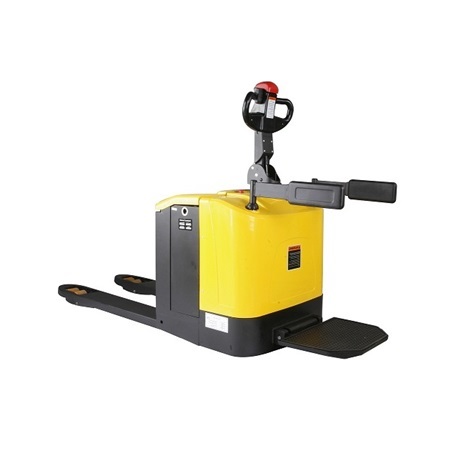
China Semi electric remote control forklift truck self lifter pallet stacker
Keyword:Electric Pallet Trucks Time:2019-11-4 0:28:17
Disassembly Method of Hydraulic Pipeline System of pallet Truck
1. Before disassembly, it should be noted that before disassembly and installation, the switch should be placed in the closed position, the battery plug should be disconnected, and the residual pressure of the conduit should be released by the control rod. Keep the working environment clean and avoid sitting inside. When disconnecting the catheter, cover all parts with a cloth to avoid oil pollution. Foreign bodies should not be allowed to enter when connecting the catheter. Removal of spare parts should be placed on cleaning paper or cloth, and use should be hours to avoid pollution, scratches or dents. Suspension and lifting need professional storage electric pallet maintenance personnel. Handling heavy objects requires two people to work together.
2. Pallet truck winding sealing tape on tapered thread. No fragments of sealing tape are allowed to enter hydraulic pipeline. When connecting each hydraulic element, O-rings are used in the joints. Before installation, a guide is installed on the joints thread and then inserted along the O-rings to avoid damaging the O-rings. It is necessary to tighten the joint by hand and determine the position of the joint before tightening the locking nut to the specified torque.
3. Release the hydraulic oil before dismantling the suction pipe.
4. The hose should be replaced before disassembly to check whether the hose is leaking, aging or damaged. Leakage or damaged connectors should be replaced.
5. The catheter should be checked for leakage, bending, breakage or abrasion before disassembly. The catheter should be notified to the storage electric pallet truck maintenance company for replacement. Leakage or damaged connectors should be replaced.
How to solve the oil leakage when the pallet truck gear pump works?
Oil leakage of pumps makes a lot of hydraulic energy become heat energy, which makes oil temperature rise and working conditions deteriorate. The oil leakage of gear pump can be divided into internal leakage and external leakage. The internal leakage reduces the output flow of pump and the pressure rise is not high. Besides the above disadvantages, the external leakage also pollutes the environment, so it is necessary to reduce the internal leakage and avoid the external leakage. The method to reduce the internal leakage is to adjust the movement clearance of the pump appropriately. If the clearance is too large, the internal leakage will increase; if the clearance is too small, the friction will increase. Causes of leakage:
1) The oil return hole on the front and rear pump caps is blocked or not drilled during processing. This requires cleaning or drilling.
2) Pump cover and seal ring cooperate too loosely to form oil leakage, which can be solved by adjusting clearance.
3) The lip of the shaft seal is scratched by the key groove of the spindle or the skeleton spring falls off. This can be replaced or reinstalled.
4) Serious scratches on the sealing surface of parts. The sealing surface should be re-studied to eliminate scratches.
5) The inner diameter of the groove is too small or the chamfer of the groove is too small, which makes the oil package inclined and causes oil leakage. Dimensions of grooves shall be checked and grooves or chamfers shall be machined according to regulations.
6) Shaft chamfer is too rough or chamfer is too small, so that the seal lip roll, should check the roughness or chamfer. When assembling, grease should be applied at the chamfer.
7) Seals should be replaced if they are used too long at high temperature, or if the seals are not well gelatinized, or if they are improperly assembled and lose elasticity, resulting in leakage.


- No information
-
1. Design objective of electronic crane scale network management. (1) Adopt advanced distributed data processing techno…
-
Electronic crane scale bearing platform installation to focus Electronic crane scale can be installed generally on the li…


